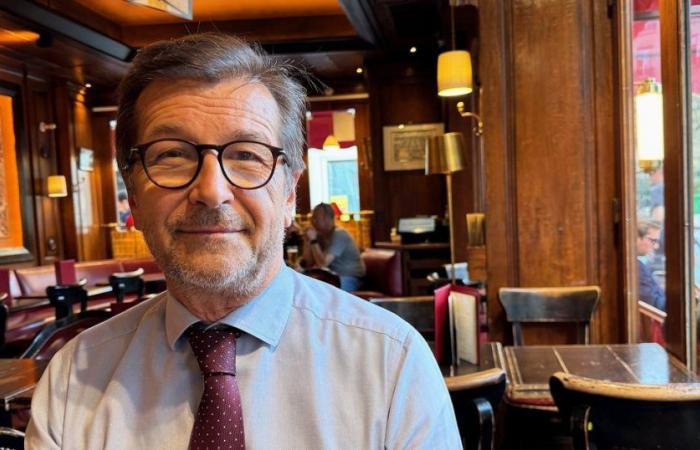Jacques PERCHE, Founder of myse.museum. © AM/APP
The African continent represents only 0.3% of the world’s museums, but several of them have achieved international notoriety, and the African museum sector seems to have a bright future, provided that funding is sufficient. A necessity to which new technologies provide innovative answers.
.
by Jacques PERCHE
Founder of myse.museum
(Paris)
.
“Art in all its forms is fundamentally and probably what is most human in our societies. Protecting it, exposing it, promoting it to as many people as possible is one of the best ways to develop everyone’s human sense.” These are the words that Katherine Fleming, President of the Getty Trust in Los Angeles, recently spoke about the vocation and future of Museums.
With a turnover of $57 billion in 2023, the global museum world is today a sector of activity in its own right. We are far from the cabinets of curiosities and royal collections reserved for the elite courts in 17th century Europe.e century.
The British Museum (1753) and the Louvre (1793) opened their collections to the general public at the end of the 18th century.e century, then these colonial powers took advantage of their expansion to develop their activity and create museums everywhere in different countries.
Today, more than 100,000 museums are listed in the world by UNESCO. And if the appeal of the general public is only very recent, it has experienced double-digit growth since the beginning of the 21st century.e century in certain regions.
.
The influence of expertise
French museum
.
The African continent represents 0.3% of museums in the world. With the richness of its cultural and historical heritage, the development of cultural tourism, the growing urbanization of populations, the policy of restitution of cultural property, it will count in the global growth of the sector. France brings its expertise and collaborates on numerous African museum projects. Let us cite, among them, the museum of black civilizations of Dakar, of memory and tolerance in Rwanda, the national museum of Mali, that of the civilization of Côte d’Ivoire, the national museums of Benin, Cameroon, Kenya , from Nigeria.
By 2030, the museum sector will represent an activity of 100 billion dollars. This activity is accompanied by the development of museum engineering which, like the digital world, is increasingly sophisticated and specialized.
The Louvre Abu Dhabi is an emblematic example of French know-how in museum engineering, covering architectural design, the establishment of the conservation and restoration department, collections management, scenography, and policy. temporary exhibitions, relying on the use of new technologies, marketing and communication.
In this regard, French museum expertise is an excellent export product, particularly in India and Asian countries. Contemporary art museums Shanghai, Tokyo, Hanoi; the National Museum of Seoul in Korea, and Delhi in India, to name but a few, have all called on French museum expertise in recent years.
.
The different approaches
the question of financing
.
The only downside to this flourishing sector lies in the sustainability of museum projects. The COVID period was a cruel reminder that the exhibition and promotion of cultural heritage required thinking “ecosystem”, with the diversification of sources of income and the attraction of the general public.
The elitist heritage of the museum world is undoubtedly not for nothing in the lack of reflection on the economic models and profitability of museums.
Like the national airlines of yesteryear, which embodied prestige and national pride, until recent times, museums did not have to worry about financing their activities, or meeting public expectations, reserving their doors to connoisseurs and specialists.
The increase in the entrance fees to the Louvre at the start of the year sparked controversy around the vocation of the museum. Were we going to prevent low-income people from accessing culture?
Should it be paid or free? What maximum price can we charge for ticketing and under what conditions? What impact on attendance? What are the alternative or complementary sources of income? So many questions, so many answers.
The Anglo-Saxon world has been banking on non-paying for decades. In France, the major museums charge a fee, those in the city of Paris – Carnavalet, Palais de Tokyo, Petit Palais – are free. The mass is not said but the medium and long term economic imperatives require reflection.
Public subsidies for museums (governmental, international funds.) represented 40% to 60% of their budget before COVID, a figure that obviously varies depending on the country, but which gives the measure of the dependence of museums on public funding. In Anglo-Saxon countries, foundations, associations and private donors are taking over from public authorities. But it is in museum activities that new sources of income are emerging. Museum shops now represent between 15% and 30% of revenues, as do cafes and catering or the privatization of venues for events.
.
New experiences
and new income
.
The emergence of digital solutions offers museums new visitor experiences – such as immersion in virtual reality for temporary exhibitions – and new revenue. However, they require significant investments and the ROI remains uncertain, between 1% and 5% of income for virtual tours and online stores.
In the United States, institutions such as the Broad Museum or the Getty Museum are considering how to ensure their long-term sustainability without resorting to subsidies of any kind. This reflection led to an unstoppable logic: to increase revenues, we must attract more audiences. To attract more audiences, we must meet their expectations. To meet their expectations, we must offer them attractive, fun, innovative, affordable visiting experiences, which leave a lasting memory of their visit to the museum – which is also the best way to develop the quality of the positive rumor around the museum. museum.
The younger generation (Z, Y etc.) represent significant development potential, as do populations who do not spontaneously access the world of the arts… but they all have a smartphone in their pocket.
.
With Myse, the catalog
tailor-made for your visit
.
For example, it is in this sense that the company Myse (My Selection) designed a simple product which responded to a wish of many museum visitors: to be able to leave with the catalog of works that they had liked during their visit. Who hasn’t experienced the frustration of buying the museum catalog where you can’t find your favorite work?
Based on mobile technology, the Myse platform requires no investment from the museum while offering the double benefit of a new experience of visiting the Museum and a unique and personal printed product.
By selecting the works of his choice during his visit, he creates the personalized catalog of his visit, printed on site, and allows you to leave the museum with a unique souvenir of its kind.
It is a solution that generates additional income for the museum, without investment, and provides a new experience for the visitor.
The Myse solution is part of this new trend of combining digital and field reality. At the same time, it offers a contribution to the need to finance the enhancement of cultural heritage.
With the entry of artificial intelligence into the world of museums, the opportunities are almost endless to generate new sources of income (or savings, etc.) thanks to personalized visits (see Myse), optimization of routes visitor, scenography, personalized content and derivative products on demand.
Reproducing the painting of the Mona Lisa, or an African mask based on a selfie, becomes possible. As Katherine Fleming mentioned at the end of her interview, is this kind of possibility frightening, kitsch, disrespectful to artists? Perhaps sometimes we need to know how to set limits to what is possible.
We are living at a crossroads for the sector. Established on the basis of a long tradition of European origin, its growth potential is linked to its globalization, new economic models, digital technology and artificial intelligence. For those who do not yet have a project in this sector, there is still time to get on the train.
………
Sources :
CA worldwide
https://www.gminsights.com/fr/industry-analysis/museums-market
https://www.kentleyinsights.com/museums-market-size/
Number of museums in the world
https://www.statista.com/topics/7489/museums-worldwide/#topicOverview
Distribution of museums according to geographical areas: UNESCO report on the state of museums in 2020 (Page 5 of the report
https://unesdoc.unesco.org/ark:/48223/pf0000376729
.
◊ ◊ ◊ ◊ ◊ ◊ ◊ ◊ ◊ ◊ ◊ ◊ ◊ ◊ ◊ ◊ ◊ ◊ ◊ ◊ ◊ ◊ ◊ ◊ ◊ ◊ ◊ ◊ ◊ ◊ ◊ ◊ ◊ ◊ ◊
CAAP XIV: Nine ambassadors and full house at UNESCO for the XIVe Conference of Paris Ambassadors, dedicated to cultural diplomacy (reports currently being written).
A view of the room during the XIVe Conference of African Ambassadors in Paris. Organized at UNESCO by AfricaPresse.paris and CAPP (Club Afrique de la Presse Parisienne) on September 25, 2024, it was dedicated to “Cultural diplomacy, a vector of excellence in Africa-France-Gulf cooperation”. © Hady Photo
.
………
THE XVe CONFERENCE OF AFRICAN AMBASSADORS OF PARIS will be held at the end of November, on the theme: “The bright future announced for railways in Africa”
Candidate expert panelists and corporate sponsors wishing to participate, make yourself known to: [email protected]
◊ ◊ ◊






